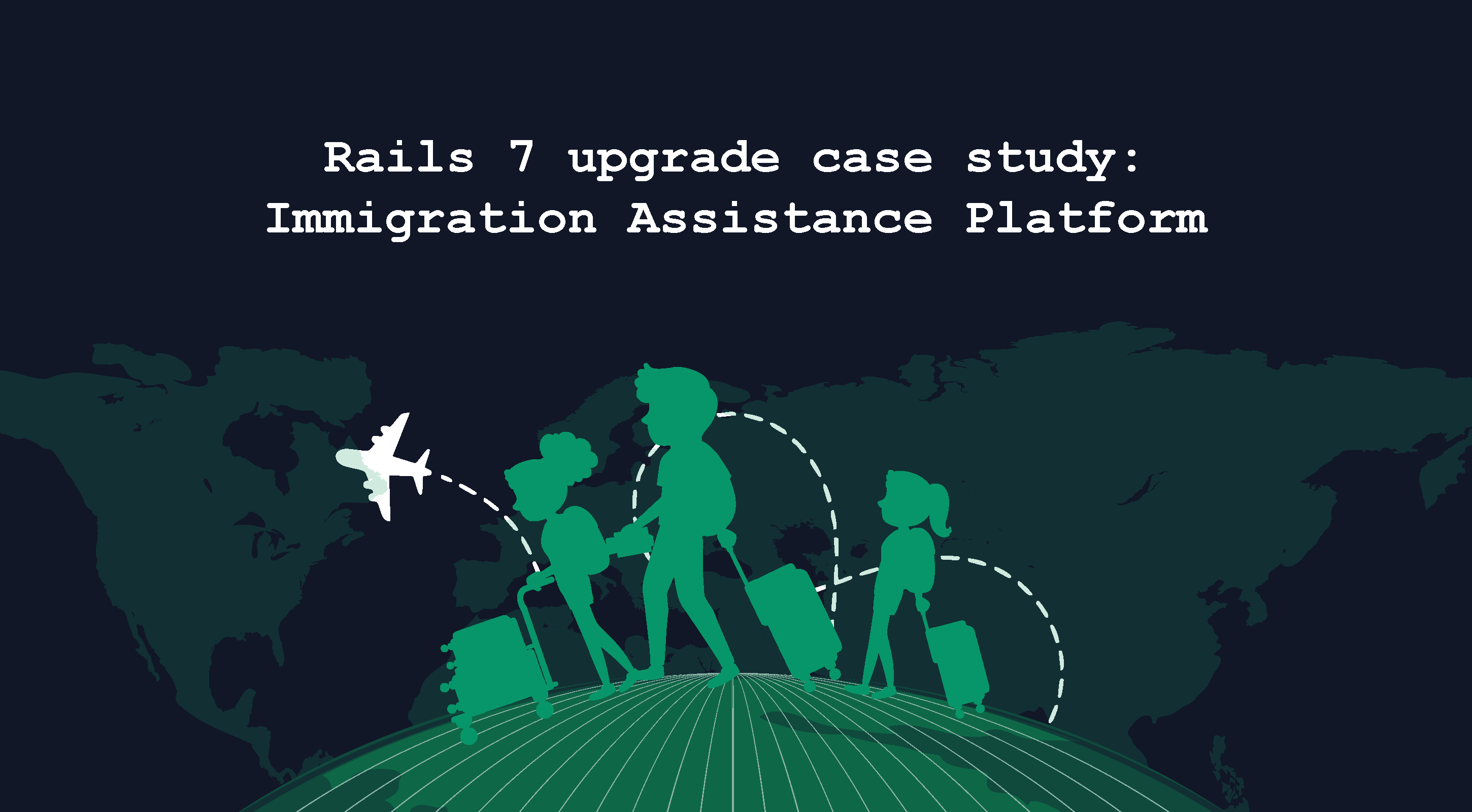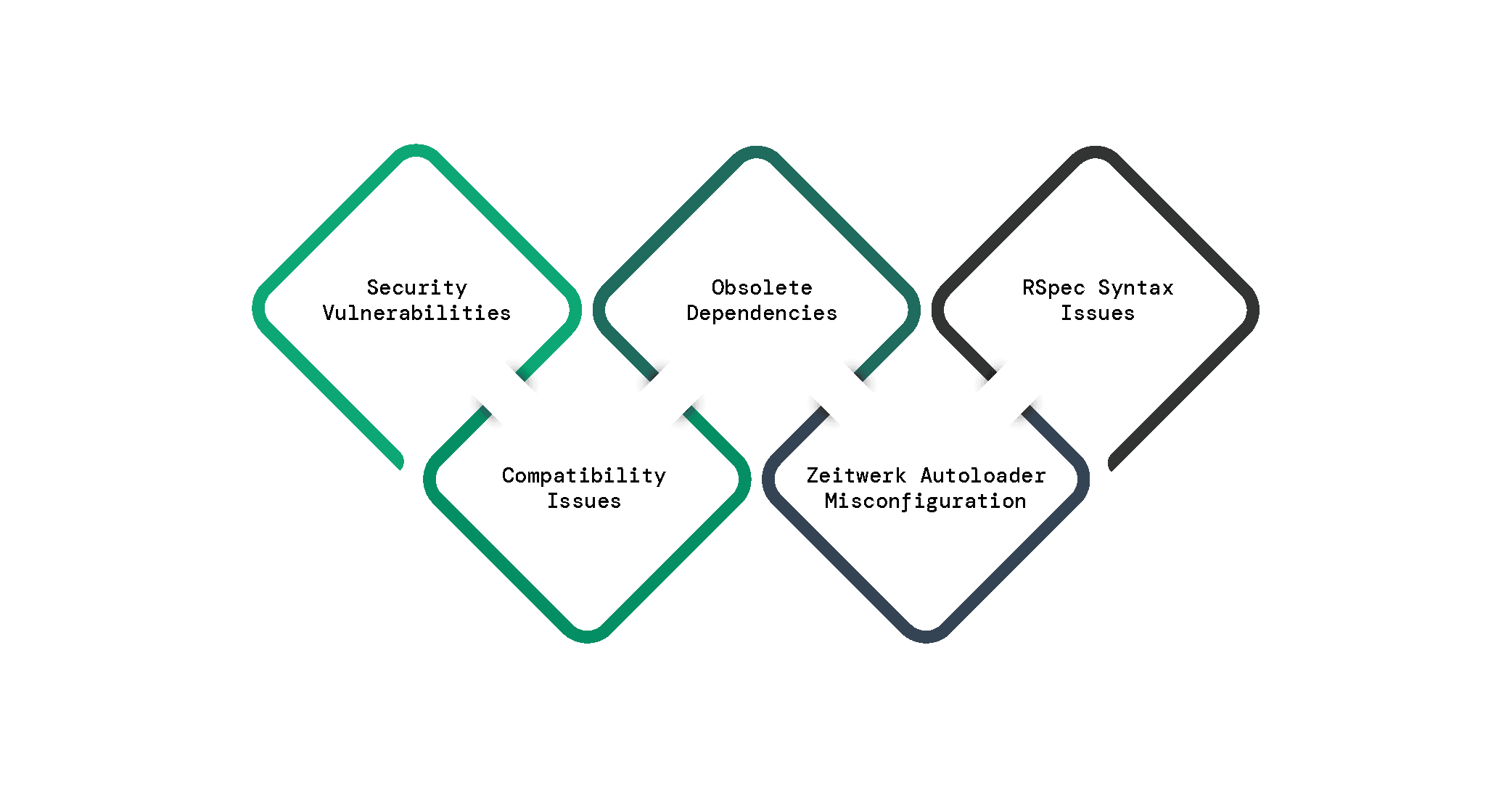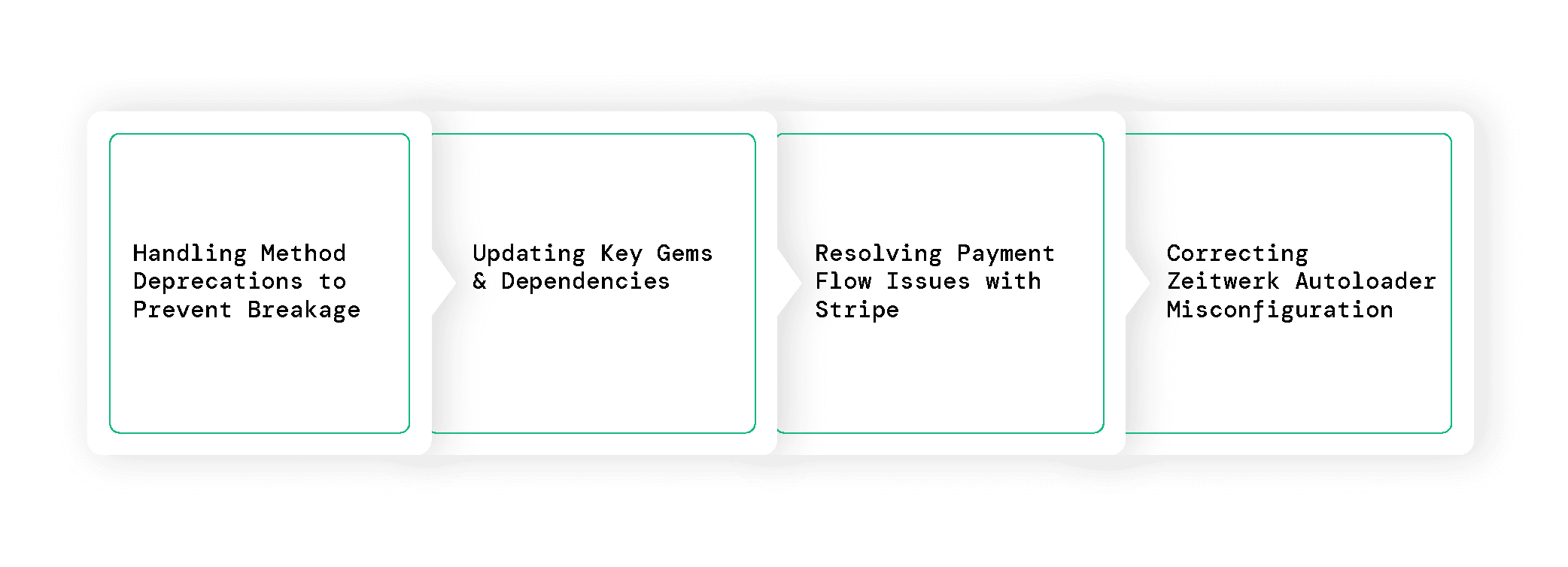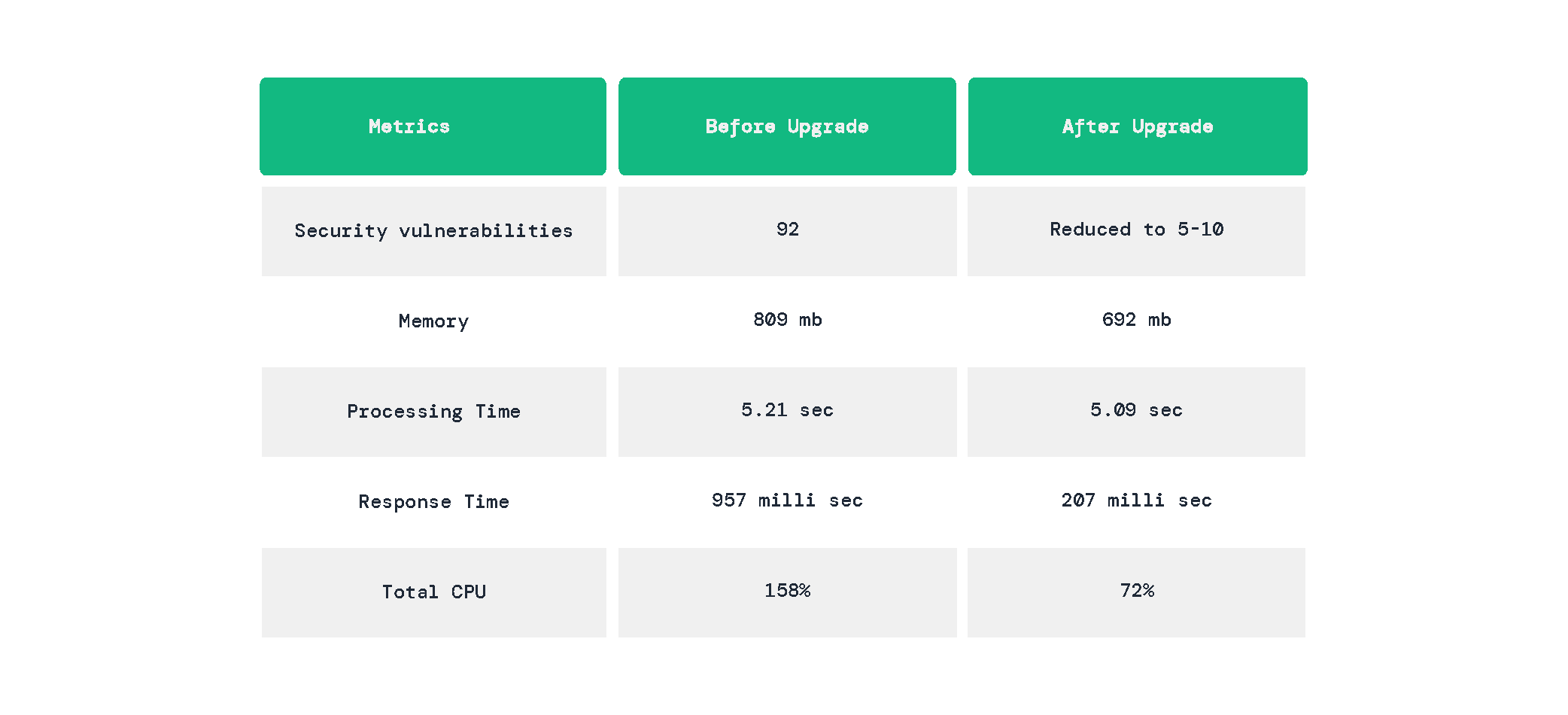Successful Rails 7 Upgrade: Slashed Security Risks by 90% for an Immigration Platform
Learn how we upgraded the Rails app of an immigration assistance platform from 6 to 7.1—seamlessly and securely.

Business Requirement:
Our client, an US-based organization, provides technology-driven solutions for simplifying the U.S. immigration process. From strategy, planning to execution and compliance, our client makes every step of immigration easy for their customers.
The client application was operating on Rails 6, which had reached the end of its security support. With no option to delay, they had to upgrade the rails version to maintain application security, performance, and compliance with industry standards.
Some of the key gems they relied on, including rack-throttle-maintenance, were no longer actively maintained in their current version. This made migrating to Rails 7.1 essential, requiring the replacement of outdated dependencies while maintaining system stability. With a user base exceeding 70,000 families since its inception in 2017, it was crucial for our client to execute these upgrades without disrupting active development cycles, thereby ensuring uninterrupted service for its clients.
Objective
The primary goal was to seamlessly upgrade the client's application from Rails 6 to Rails 7.1 while ensuring minimal disruption to daily operations.
Challenges
The client’s application was facing various complexities affecting security and performance. We began by conducting a thorough analysis to identify the root causes and potential risks. Through in-depth evaluation, we uncovered multiple challenges across infrastructure, authentication, and testing which required immediate attention.

Security Vulnerabilities
The Client's Rails version no longer received critical security patches, leaving their application exposed to potential threats. Given that the client’s business handles sensitive immigration-related data, any breach could lead to severe legal and operational consequences.
Thus, upgrading a Ruby on Rails application with enhanced security mechanisms became essential to mitigate risks and ensure compliance with industry standards.
Compatibility Issues
As Rails ecosystem evolved by the day, newer libraries, gems, and third-party integrations started dropping support for Rails 6. This created significant roadblocks in adding new features and improving application performance.
As a result, developers frequently encountered breaking changes when trying to integrate with APIs, payment gateways, and authentication services. Without an upgrade, client application risked being locked into a rigid tech stack, making future development increasingly complex and resource intensive.
Obsolete Dependencies
Many of the project's dependencies, including middleware and background job tools, were outdated and no longer maintained, making it hard to ensure stability, performance, and security.
Some gems had hardcoded dependencies incompatible with newer Rails versions, causing frequent issues. It necessitated us to evaluate, replace, or fork these libraries, adding complexity to the upgrade process and requiring extensive testing to avoid unexpected failures.
Zeitwerk Autoloader Misconfiguration:
The project faced several structural issues related to the Zeitwerk autoloader. The client’s team had placed app-related constants within the app/ directory instead of the appropriate lib/ directory at the project root, which led to complications that required resolution.
RSpec Syntax Issues:
Various syntax issues surfaced during RSpec testing, requiring careful debugging and modifications to align with the updated Rails version and testing framework best practices.
Approach
To ensure a smooth and risk-free upgrade, our expert team at Railsfactory, followed a phased approach, starting with a detailed discovery and planning phase.
Our developers began by analyzing the existing codebase, identifying deprecated dependencies, and assessing potential compatibility issues. A structured roadmap was created, outlining key milestones, risk mitigation strategies, and testing plans to minimize disruptions during the transition.
Rather than upgrading directly to Rails 7.1, we adopted an incremental upgrade strategy. First, we transitioned from Rails 6 to 7, addressing deprecations and ensuring stability. Following that, we advanced to Rails 7.1. Over a three-month period, we carefully balanced ongoing development with stability, ensuring the ruby on rails upgrade was completed without impacting business operations.
Solution
Upgrading a high-traffic app is not easy, but with expert Rails developers, it can be done efficiently. From fixing broken dependencies to resolving authentication and payment issues, our Rails experts carefully planned and executed every step, taking a structured approach to ensure a smooth and successful upgrade to Rails 7.1.

Handling Method Deprecations to Prevent Breakage
During the upgrade, we encountered various method deprecations that could have led to application failures. To mitigate this, we carefully reviewed affected methods, replacing deprecated calls with their recommended alternatives. This proactive approach helped to ensure that the application remain stable and fully functional throughout the transition.
Updating Key Gems and Dependencies
To maintain compatibility with Rails 7.1, we systematically updated all critical gems and dependencies to their latest stable versions. This process involved extensive testing to ensure seamless integration, resolving any conflicts that arose due to API changes or deprecations.
Resolving Payment Flow Issues with Stripe
As the existing Stripe gem was automatically upgraded alongside Rails 7, we faced unexpected payment flow disruptions. After thorough debugging, we identified that the newer Stripe version introduced changes which are incompatible with the existing implementation.
To restore functionality, we reverted to a stable older Stripe gem version that worked seamlessly with the application’s payment logic.
Correcting Zeitwerk Autoloader Misconfiguration
The application’s autoloading structure was not fully compatible with Zeitwerk, as certain constants were improperly placed in the app/ folder instead of root/lib/. This misconfiguration led to namespace conflicts and loading errors.
We resolved this by restructuring the application’s directory hierarchy, ensuring that all constants and dependencies were loaded correctly under Zeitwerk’s conventions. This change significantly improved maintainability and performance.
Benefits
Advanced Security
Before the upgrade, we identified 92 security vulnerabilities in the client’s application. By upgrading to Rails 7.1 and implementing its enhanced security updates, we successfully reduced this number to a range of 5-10, ensuring stronger data protection and minimizing risks.
Optimized Performance
For an immigration platform managing high application volumes, speed and efficiency are critical. With Rails 7.1’s improved caching and query optimizations, we enhanced processing time (5.21 sec to 5.09 sec), memory (809 mb to 692 mb) and response times (957 milli sec to 207 milli sec). This ensures faster application submissions, smoother document handling, and a seamless experience for users navigating the immigration process.
Enhanced Background Job Performance
With Rails 7.1’s improvements to Active Job, including better error handling, smarter retries, and optimized logging, the client’s team now ensure more reliable background task execution. Combined with enhanced database connection pooling, the upgrade reduced processing time for critical workflows, making application processes smoother and more efficient.
Stronger Scalability
The improved database connection pooling and optimized Active Record query execution with upgraded version helped the client’s application efficiently handle increased traffic and user loads. These enhancements reduced connection overhead and ensure smoother performance under high demand, allowing the platform to scale without bottlenecks.
Future-Proof Compatibility
The upgrade ensures seamless integration with modern libraries, third-party APIs, and evolving web technologies. It, in turn, will minimize technical debt and simplify future upgrades for the client. Additionally, its enhanced support for newer Ruby versions and framework improvements helps maintain long-term stability and adaptability.

Conclusion
The Rails 7.1 upgrade strengthened the client’s application by enhancing security, improving performance, and ensuring long-term maintainability. By resolving deprecated dependencies, optimizing background job execution, and leveraging improved database handling, we ensured a seamless transition with minimal disruption in just 2.5 months.
The platform is now more scalable, efficient, and compatible with modern technologies, allowing the client’s team to focus on growth rather than technical debt. With a solid foundation in place, their immigration platform is well-prepared to handle increasing demand while maintaining compliance and operational excellence.
Your one-stop shop for expert RoR services.
Join 250+ companies achieving top-notch RoR development without increasing your workforce.
